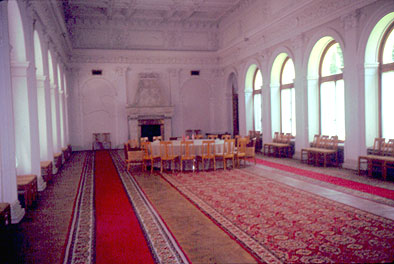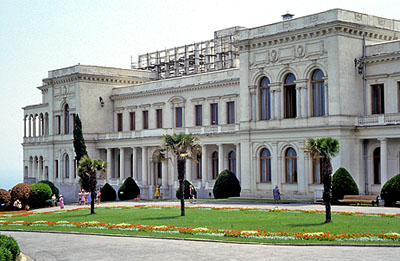
Yalta Meeting Room

So, what was the Cold War? In simple terms the Cold War was the non-shooting war, i.e., the non "hot" war, waged between the United States and its allies and the Soviet Union and its allies from about late 1945 to the breakup of the Soviet Union in 1991. The start and end dates of the Cold War are subject to a lot of variable interpretations. While the Soviet Union and the United States were never directly engaged in shooting at each other, that did not mean that there were no wars. In fact, there were an awful lot of wars and conflicts around the globe fought between proxies for the superpowers (and also involving the superpowers themselves) and in different circumstances from Korea to Vietnam to Cuba to Angola and Ethiopia to Afghanistan and the Sinai Peninsula.
The wartime alliance between Russia, England and America had not been without its strains. Remember before World War II, relations between the Soviet Union and England and America had been close to nonexistent. They became allies by fact, not choice, in 1941. Through 1942 and 1943 as the Russians bore the brunt of the German attack, Stalin repeatedly asked his allies for a second front on the continent, and he was suspicious when the allies did not invade France--He never understood the burdens of the war in the Pacific on the United States. The allies also had a hard time getting supplies to Russia. It was just not easy reaching Russian ports given the German U-boats and the problems with weather.
Many historians/analysts have pointed to the Yalta Conference (4-11 February 1945) as the real start of the Cold War, and there have been repeated criticisms raised about the behavior of President Roosevelt and Prime Minister Churchill in "selling out" Eastern Europe to the Soviets at the conference. There is also some valid critique of the decision to hold the conference in the Crimea, necessitating a halfway-around-the-world journey by an American president who just a little over two months away from his death. So what was agreed at the conference?
From the American perspective, the absolutely crucial point was the Soviet agreement to enter the war in the Pacific against Japan within three months of the German surrender (see, Agreement Regarding Entry of the Soviet Union into the War against Japan, which is the last part of the formal protocol of the Yalta conference). There would be some territorial compensation for the Soviets in exchange for that. The Americans felt that Soviet aid in the final struggle against Japan was absolutely crucial because of estimates of high casualties in the upcoming assault on the Japanese home islands--numbers as high as one million dead had been tossed around. The Americans needed the Soviet Army; the atomic bomb was still not a viable option.
Also, high on the American agenda was the proposed United Nations (UN), which would be an improved upon League of Nations. What was agreed at Yalta was that the Soviet Union would participate in the UN. The idea of the Security Council was also okayed.
Stalin, Roosevelt and Churchill also easily agreed on the principle that Germany was to be disarmed and demilitarized, but very vague language was adopted with the details to be worked out at the next conference after Germany's surrender. Germany was going to be divided into zones of occupation. Some of the nasty fine print involved the redrawing of German borders with large sections of Eastern Germany to be annexed by Poland and Russia--basically Poland was going to be moved about one hundred miles westward. Fifteen million Germans were going to have to be relocated.
Now here comes the real murky point. There was an agreement that was supposed to ensure free and democratic elections in all of liberated Europe, but no one really provided the details about what "free" and "democratic" meant. When the Soviets set up communist-controlled governments in most of the East European countries, there was a lot of consternation in the West, but there was not going to be any real challenge to Soviet actions since the Soviet Army was firmly in control of most of the continent east of Berlin. Not really mentioned in any of the discussions about the future of Eastern Europe was the famous Churchill-Stalin percentages agreement from October 1944, when Churchill, in Moscow to meet with Stalin, had exchanged a slip of paper with Stalin that divided up the Balkans into spheres-of-influence between the Soviet Union and Britain.
Poland proved to be the real spark
of the emerging Cold War; remember
it was Poland where World War II had started--due to the
complicity of Stalin and Hitler--and there was a legacy of centuries of
Russo-Polish antagonism at work. Stalin claimed that throughout
history Poland had either attacked Russia or had been used as a
corridor through which other hostile countries had attacked
Russia. So Stalin wanted a pro-Communist government in Poland to
guarantee the security of the Soviet Union.
There was not a whole lot of goodwill on both sides of Russo-Polish relations. During the war, the Katyn Forest Massacre had occurred, and there had been repeated disappearances of Polish officials and intellectuals at the hands of the Soviets. So how were there ever going to be "free"--in the American definition of the term--elections in Poland? Who was going to monitor and enforce the requirement of "free and unfettered elections?" What was going to be construed as a democratic government friendly to the Soviet Union? The allies, the Polish government-in-exile in England and the Soviets could never agree upon the composition of a new government. So, since the Soviet Army had already occupied Poland, Stalin set up his own government and proceeded to establish de facto Soviet control in Poland. One of the things that he did was shift Poland westward, claiming previously-Polish territory for the Soviet Union and giving Poland previously-German territory, which meant that Poland would have to rely on the Soviet army to make sure that the Germans never tried to get that territory back. The constant bickering over the composition of the Polish government, the sovietization of Poland (purges, executions, disappearances) all dramatically heightened tensions between the Soviet Union and England/America.
By 1946, it was clear that the Soviets and Anglo-Americans had different perspectives on what had taken place, and what was going to be taking place, in Eastern Europe.
On 5 March 1946, Winston
Churchill, speaking at Westminster College,
in Fulton, Missouri, with President Harry Truman on the stage with him,
exclaimed that
"From Stettin in the Baltic to Trieste
in the Adriatic an iron curtain has descended upon the
continent," separating the free and democratic west from
the Soviet-controlled East. (The complete text
of Churchill's remarks is available; the speech is also known as "The
Sinews of Peace.") Stalin responded in nasty language,
comparing
Churchill to Hitler, "One is reminded remarkably of Hitler and his
friends. Hitler began to set war loose by announcing his racial
theory, declaring that only people speaking the German language
represent a fully valuable nation. Mr. Churchill begins to set
war loose, also by a racial theory, maintaining that only nations
speaking the English language are fully valuable nations, called
upon to decide the destinies of the entire world." (Stalin's
interview, published in Pravda, 14 March 1946, is partially available online.)
By mid-1946, there really was a Cold War underway.

Livadia Palace, constructed for tsar Nicholas II in 1911,
site of the Yalta Conference in February 1945
It was often tricky to determine exactly
what was going on in the communist world during the Cold War; it was
like trying to unravel a puzzle. Take a look at what
Kremlinologists did in the example of the 1960 Moscow Conference of communist parties, and some
accompanying information on the outbreak of the Sino-Soviet split in the early 1960s.
In addition, remember that the Cold War was not just about high-level international politics, the CW had a profound effect on peoples' lives. You can read some short recollections about the Cold War in Bulgaria.
We might ask the logical question of when did the Cold War end?
One possible answer would be 1953 with the death of Stalin, and another
good choice would be 1955 with the proclamation by Khrushchev of the
idea of "peaceful coexistance."

Though it sometimes seems difficult to grasp today the seriousness with which the Cold War played itself out in the decades after Word War II, the Cold War was not an abstraction; nor was it only confined to places far-removed from the continental United States. In fact, for the residents of Fairfax county, the Cold war had some clear evidence of its dangers, such as the presence of a series of Nike anti-aircraft batteries that were installed to protect Washington, DC from a nuclear attack delivered by any approaching Soviet bombers--I admit it is hard to figure out how the US military establishment ever figured out that Soviet bombers would get that close to DC. Take a moment and read the very interesting article by Dr. Christopher John Bright on these anti-aircraft batteries and the Cold War in Northern Virginia. Log into Blackboard and look for the article entitled "Bright Article on Nike Missile Batteries" under "Course Documents." There is also some information about Nike batteries in Fairfax on Abandonded and Little Know Airfields in Virginia: Western Fairfax.

- Julius Epstein, Operation Keelhaul: The Story of Forced Repatriation from 1944 to the Present (1973)
- Adam Ulam, Expansion and Coexistance: Soviet Foreign Policy, 1917-1973 (1974)
- John Gaddis, The United States and the Origins of the Cold War, 1941-1947 (1982)
- David Holloway, Stalin and the Bomb: The Soviet Union and Atomic Energy, 1939-1956 (1994)
- Thomas Parrish, Berlin in the Balance (1998)
- William Stueck, The Korean War: An International History (1995)
- James Nathan, Anatomy of the Cuban Missile Crisis (2001)
- György Litván and János Bak, The Hungarian Revolution of 1956: Reform, Revolt and Repression, 1953-1963 (1996)
- Some major Cold War events
- Yalta Conference and the Potsdam Conference
- Winston S. Churchill, "Iron Curtain Speech" (5 March 1946) and Stalin's "Reply to Churchill" (1946)
- Truman Doctrine or www.fordham.edu/halsall/mod/1947TRUMAN.html
- Marshall's Commencement Address at Harvard University (5 June 1947) and The Marshall Plan (the Economic Cooperation Act of 1948)
- North Atlantic Treaty (4 April 1949)
- The Warsaw Pact, 1955
- Hungary 1956
- The U-2 Incident 1960
- The Berlin Wall goes up in 1961 and comes down in 1989
- Nikita Khrushchev: Address to the UN General Assembly, Sept. 23 1960
- USA and USSR: Exchange of Notes on the Berlin Wall, 1961
- The Brezhnev Doctrine, 1968
- Cold War sites
- Harvard Project on Cold War Studies
- The Parallel History Project on NATO and the Warsaw Pact (now the Parallel History Project on Cooperative Security)
- Red Files includes websites on the Secret Soviet Moon Mission, Soviet propaganda, Soviet Sports Wars and Secret Victories of the KGB
- The Cold War International History Project, includes topics such as:
- The Soviet-led Intervention in Czechoslovakia
- Stalin's Plan to Assassinate Tito
- Soviet Espionage and the Bomb
- New Evidence on the Korean War (documents and analysis)
- New Evidence on the 1956 Polish and Hungarian Crises
- New Evidence on the Cuban Missile Crisis
- New Evidence on the 1980-81 Polish Crisis
- New Evidence on the Soviet Intervention in Afghanistan
- New Evidence on the End of the Cold War
- New Evidence on the Soviet Invasion of Czechoslovakia
- New Evidence on the East German Uprising of 1953
- New Evidence on the Vietnam/Indochina Wars